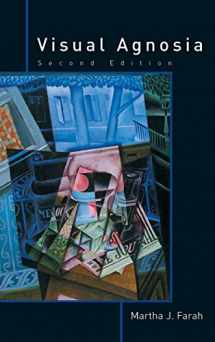
Visual Agnosia
ISBN-13:
9780262062381
ISBN-10:
0262062380
Edition:
2
Author:
Martha J Farah
Publication date:
2004
Publisher:
Bradford Books
Format:
Hardcover
176 pages
FREE US shipping
Book details
ISBN-13:
9780262062381
ISBN-10:
0262062380
Edition:
2
Author:
Martha J Farah
Publication date:
2004
Publisher:
Bradford Books
Format:
Hardcover
176 pages
Summary
Visual Agnosia (ISBN-13: 9780262062381 and ISBN-10: 0262062380), written by authors
Martha J Farah, was published by Bradford Books in 2004.
With an overall rating of 3.6 stars, it's a notable title among other
books. You can easily purchase or rent Visual Agnosia (Hardcover) from BooksRun,
along with many other new and used
books
and textbooks.
And, if you're looking to sell your copy, our current buyback offer is $0.3.
Description
The cognitive neuroscience of human vision draws on two kinds of evidence: functional imaging of normal subjects and the study of neurological patients with visual disorders. Martha Farah's landmark 1990 book Visual Agnosia presented the first comprehensive analysis of disorders of visual recognition within the framework of cognitive neuroscience, and remains the authoritative work on the subject. This long-awaited second edition provides a reorganized and updated review of the visual agnosias, incorporating the latest research on patients with insights from the functional neuroimaging literature. Visual agnosia refers to a multitude of different disorders and syndromes, fascinating in their own right and valuable for what they can tell us about normal human vision. Some patients cannot recognize faces but can still recognize other objects, while others retain only face recognition. Some see only one object at a time; others can see multiple objects but recognize only one at a time. Some do not consciously perceive the orientation of an object but nevertheless reach for it with perfected oriented grasp; others do not consciously recognize a face as familiar but nevertheless respond to it autonomically. Each disorder is illustrated with a clinical vignette, followed by a thorough review of the case report literature and a discussion of the theoretical implications of the disorder for cognitive neuroscience. The second edition extends the range of disorders covered to include disorders of topographic recognition, and both general and selective disorders of semantic memory, as well as expanded coverage of face recognition impairments. Also included are a discussion of the complementary roles of imaging and patient-based research in cognitive neuroscience, and a final integrative chapter presenting the "big picture" of object recognition as illuminated by agnosia research.


We would LOVE it if you could help us and other readers by reviewing the book
Book review

Congratulations! We have received your book review.
{user}
{createdAt}
by {truncated_author}


